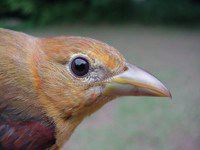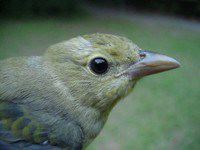 HOME: www.hiltonpond.org |
|
||
|
|
|||
|
|
|||
|
|
|||
|
|
|||
|
|
|||
|
THIS WEEK at HILTON POND |

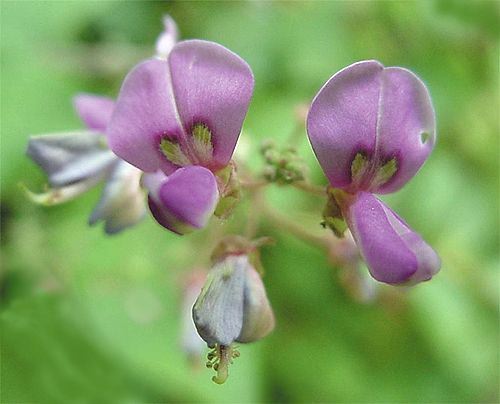 If you guessed "Tick-trefoil" as a common name for the purple flower above, you'd be right. If you've never heard of "Tick-trefoil" but said it looks like some kind of wild pea, you'd still be correct. And if you're really into plants, you might have concluded confidently that it appears to be a Desmodium, a native plant of which as many as 50 species are found across North America. But many folks probably wouldn't have a clue until they looked at the fruit from this plant at Hilton Pond Center . . . 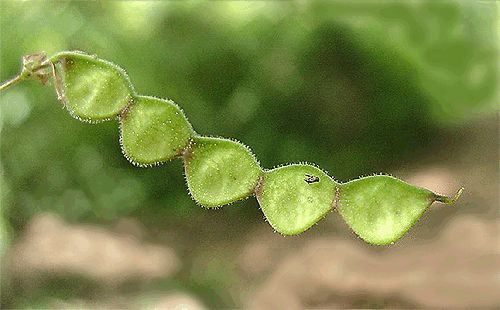 . . . and suddenly recognized that our little purple bloom is none other than "Beggar-Lice," a plant whose seeds are also called--as we painstakingly pluck them from our pantlegs--"those dad-blamed 'Sticktights'."
The scientific epithet Desmodium is from the Greek word for "chain," which refers to the way the plant forms its seeds end-to-end. Since Tick-trefoil is indeed a pea--it's in the Fabaceae (the Legume, or Pea, Family)--the chain is actually a pea-pod, In the Carolinas there are perhaps two dozen species of Desmodium, with flowers varying from white to pink to purple to blue. Most are plants that appear along fencerows or fairly early in old field succession, but a few are shade tolerant and thrive in open woods. Some Beggar-Lice plants may grow to six feet in height, but even some of the shorter species tend to tilt over almost to the ground (below left)--a mechanism that apparently improves the odds that Sticktights will come in contact with ambulating animals.
Since Beggar-Lice are legumes, the nitrogen-fixing bacteria on their roots DO enrich the soil. If for no reason other than that, we welcome Sticktights to Hilton Pond Center, in the hope they can eventually return nitrates to our nutrient-poor Piedmont red clay even as we curse them for clinging to our socks. If you enjoy "This Week at Hilton Pond," please help Support Hilton Pond Center for Piedmont Natural History You may wish to consult our Index of all nature topics covered since February 2000. |
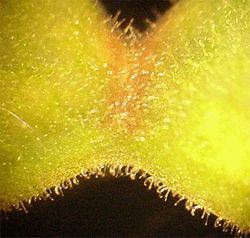 Sticktights, indeed! Each keel- shaped seed of Tick-trefoil is covered with hundreds of tiny hooks (left) that are adapted for holding onto to animal fur but seem even more capable of grabbing our garments as we wander through meadows in late summer. It's hard to imagine how a plant can disseminate its genes with a seed that adheres so tightly to its carriers; we nearly have to use a screwdriver to pry Beggar-Lice from our socks, and heaven forbid a guy with really hairy legs should stumble into a thicket of Sticktights!
Sticktights, indeed! Each keel- shaped seed of Tick-trefoil is covered with hundreds of tiny hooks (left) that are adapted for holding onto to animal fur but seem even more capable of grabbing our garments as we wander through meadows in late summer. It's hard to imagine how a plant can disseminate its genes with a seed that adheres so tightly to its carriers; we nearly have to use a screwdriver to pry Beggar-Lice from our socks, and heaven forbid a guy with really hairy legs should stumble into a thicket of Sticktights!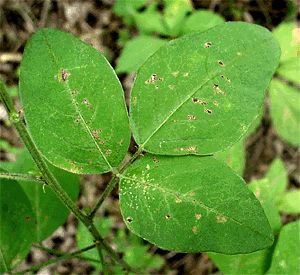 but individual peas are separated by weak joints that easily give way on contact and allow each seed to attach to a passerby. Another clue that this plant is a pea is its clover-like three-part leaf (right), which gives rise to the name "trefoil."
but individual peas are separated by weak joints that easily give way on contact and allow each seed to attach to a passerby. Another clue that this plant is a pea is its clover-like three-part leaf (right), which gives rise to the name "trefoil."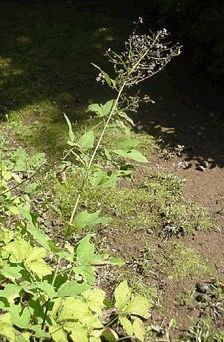 No matter what you call them-- Tick-trefoil, Desmodium, Beggar-Lice, or Sticktights--these flowers are pleasing to the eye but become a major irritation when their seeds cling so closely to our clothing. Tick-trefoils also have little apparent wildlife value. About the only animals that find them palatable are deer that occasionally browse their leaves and Bobwhite quail that eat large quantities of Sticktight seeds, and some butterflies apparently use them as host plants.
No matter what you call them-- Tick-trefoil, Desmodium, Beggar-Lice, or Sticktights--these flowers are pleasing to the eye but become a major irritation when their seeds cling so closely to our clothing. Tick-trefoils also have little apparent wildlife value. About the only animals that find them palatable are deer that occasionally browse their leaves and Bobwhite quail that eat large quantities of Sticktight seeds, and some butterflies apparently use them as host plants.